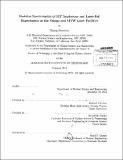Fast-ion spectrometry of ICF implosions and laser-foil experiments at the omega and MTW laser facilities
Author(s)
Sinenian, Nareg
DownloadFull printable version (69.07Mb)
Alternative title
Fast-ion spectrometry of inertial confinement fusion implosions and laser-foil experiments at the omega and Multi-Terawatt laser facilities
Other Contributors
Massachusetts Institute of Technology. Department of Nuclear Science and Engineering.
Advisor
Richard Petrasso.
Terms of use
Metadata
Show full item recordAbstract
Fast ions generated from laser-plasma interactions (LPI) have been used to study inertial confinement fusion (ICF) implosions and laser-foil interactions. LPI, which vary in nature depending on the wavelength and intensity of the driver, generate hot electrons with temperatures ranging from tens to thousands of kilo-electron-volts. These electrons, which accelerate the ions measured in this work, can be either detrimental or essential to implosion performance depending on the ICF scheme employed. In direct-drive hot-spot ignition, hot electrons can preheat the fuel and raise the adiabat, potentially degrading compression in the implosion. The amount of preheat depends on the hot-electron source characteristics and the time duration over which electrons can deposit energy into the fuel. This time duration is prescribed by the evolution of a sheath that surrounds the implosion and traps electrons. Fast-ion measurements have been used to develop a circuit model that describes the time decay of the sheath voltage for typical OMEGA implosions. In the context of electron fast ignition, the produced fast ions are considered a loss channel that has been characterized for the first time. These ions have also been used as a diagnostic tool to infer the temperature of the hot electrons in fast-ignition experiments. It has also been shown that the hot-electron temperature scales with laser intensity as expected, but is enhanced by a factor of 2-3. This enhancement is possibly due to relativistic effects and leads to poor implosion performance. Finally, fast-ion generation by ultra-intense lasers has also been studied using planar targets. The mean and maximum energies of protons and heavy ions has been measured, and it has been shown that a two-temperature hot-electron distribution affects the energies of heavy ions and protons. This work is important for advanced fusion concepts that utilize ion beams and also has applications in medicine.
Description
Thesis (Ph. D.)--Massachusetts Institute of Technology, Dept. of Nuclear Science and Engineering, 2013. Cataloged from PDF version of thesis. Page 224 blank. Includes bibliographical references.
Date issued
2013Department
Massachusetts Institute of Technology. Department of Nuclear Science and EngineeringPublisher
Massachusetts Institute of Technology
Keywords
Nuclear Science and Engineering.